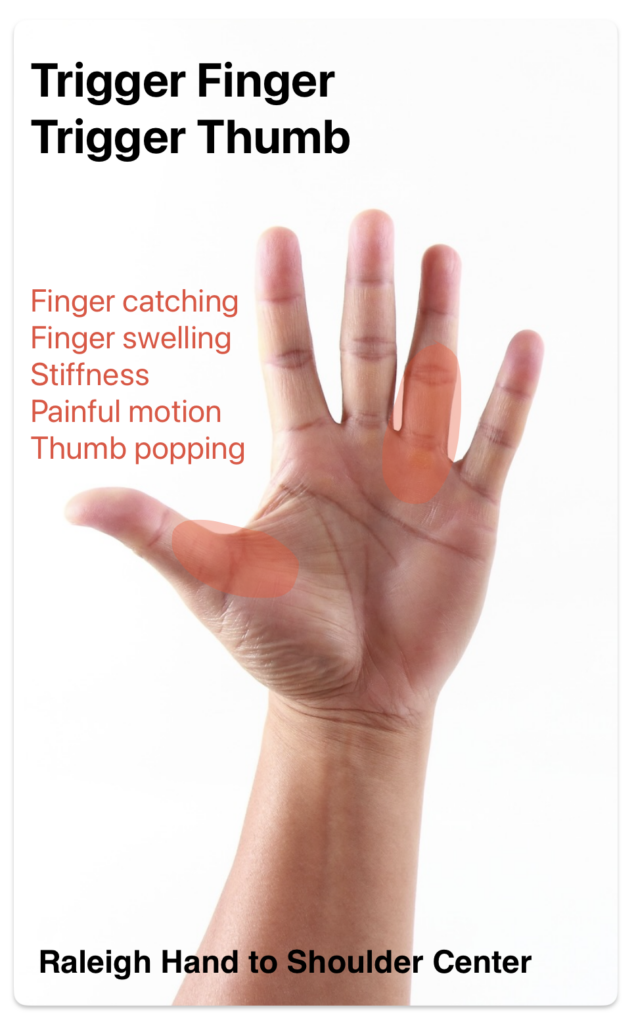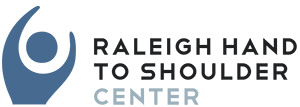
Trigger Finger
What is Trigger Finger?
Trigger finger, also known as “stenosing tenosynovitis” is a common problem. Symptoms occur when there is a size mismatch between the flexor tendons of the fingers or thumb and the sheath which surrounds the tendons. Instead of gliding smoothly through the sheath, the tendons can meet resistance within the tight sheath. Some patients report “catching” or painful “clicking” of the finger with range of motion. Some people may feel a tender nodule or “bump” at the base of the finger or thumb. In advanced cases, the finger can become stuck or “locked” in flexion, requiring the person to straighten the finger with the other hand. These symptoms are often worse in the morning.

What Causes Trigger Finger?
The cause of trigger finger is unknown in most cases. Repetitive, forceful gripping or trauma may contribute to the process. Sometimes rheumatoid arthritis (RA), diabetes, gout, and thyroid disorders are associated with trigger finger. In some conditions, the tenosynovium, which is normally thin tissue surrounding the tendons, becomes thickened and obstructs tendon gliding.
Who is at Risk of Getting Trigger Finger?
Trigger finger is more common in females than males. It typically occurs in people between 40 and 60 years of age. Diabetics and patients with RA have a higher risk. Despite the name, trigger finger can occur in any finger, and it is common in the thumb. Children may also have a trigger finger, however, this is much less common. “Congenital trigger thumb” is occasionally diagnosed in infants who cannot fully straighten the end of the thumb.
How is Trigger Finger Diagnosed?
Trigger finger can be diagnosed by history and physical exam. Laboratory tests, x-rays, ultrasound, and MRI are usually not necessary to confirm the diagnosis. Often a cyst or nodule arises from the tight sheath, which can be felt as a firm bump in the palm.
What Are Treatment Options for Trigger Finger?
Non-operative treatment is tried first as symptoms can often be relieved without surgery. Wearing a finger splint at night can rest the finger and reduce symptoms. A corticosteroid injection (“cortisone shot”) is effective in improving symptoms in many patients. Rest and avoidance of forceful and repetitive gripping may reduce symptoms. Anti-inflammatory medications such as Ibuprofen, Naproxen, and Tylenol can reduce pain.
If these measures fail to improve the symptoms, surgery may be offered. Trigger finger release surgery can be performed to improve the gliding of the flexor tendons. During this procedure, the tight sheath (called the “A1 pulley”) is released through a small incision in the palm.
What is the Recovery Process Following Trigger Finger Surgery?
The surgery is performed as an outpatient usually under local anesthesia. These days most patients do not need to be put to sleep for this procedure. Patients may use their hands for light activities immediately. Most people can return to light duty work in a few days. Normal use of the hand is resumed as comfort permits. Pain medication is often weaned in a few days. The skin sutures are removed in clinic in 10-14 days. Most patients are asked to avoid heavy/forceful use of the hand for approximately 3-4 weeks after surgery.
What Results Can Be Expected Following Surgery for Trigger Finger?
Free gliding of the flexor tendons is noticed immediately after surgery and most patients are very satisfied with their outcome. However, some patients report soreness at the incision and stiffness of the digit, which often improve over time. Recurrence of the triggering after surgery is rare.
What Are the Potential Complications of Trigger Finger Surgery?
No surgery is risk-free. However, major complications from trigger finger release are uncommon. Possible complications include pain, persistent symptoms, infection, poor wound healing, finger stiffness, and damage to the tendons or sensory nerves.
Unlock Your Finger's Potential - Discover Trigger Finger Solutions in Raleigh
Trigger finger can be a painful and limiting condition, affecting your hand's mobility. At Raleigh Hand to Shoulder Center, our specialized care is designed to address trigger finger and help you regain optimal finger function. Take the first step towards trigger finger relief today. Call our office for an appointment or schedule a visit online!
Updated 6/19/2025
Images and videos copyright American Society for Surgery of the Hand.

